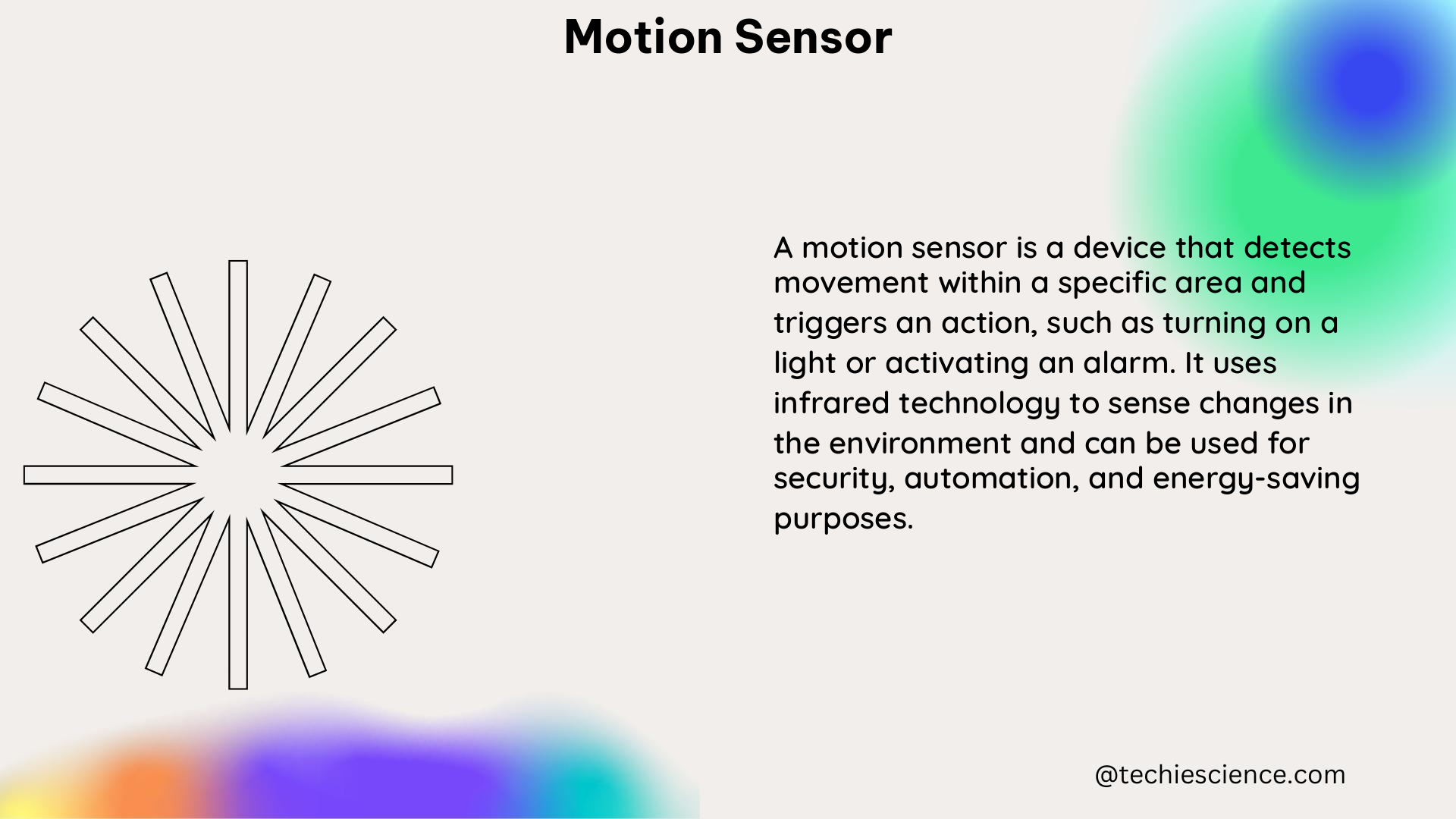Motion sensors are versatile devices that can detect and measure movement, providing valuable data for a wide range of applications, from scientific research to home automation and security systems. These sensors utilize various technologies, such as ultrasound, infrared, or radar, to capture the motion of objects, people, or even subtle vibrations. By understanding the technical specifications and features of motion sensors, you can unlock their full potential and harness the power of quantifiable movement data.
Understanding the Technical Specifications of Motion Sensors
Range
The range of a motion sensor refers to the distance at which it can detect movement. This is a crucial specification, as it determines the area or volume that the sensor can effectively monitor. For example, the Go! Motion Sensor from Arbor Scientific has a range of 0.15 to 6 meters, allowing it to detect movement within a sizable space.
Resolution
The resolution of a motion sensor is its ability to distinguish between small and large movements. This is typically measured in millimeters (mm) or micrometers (μm), depending on the sensor’s sensitivity. The Go! Motion Sensor has a resolution of 1 mm, meaning it can detect movements as small as 1 millimeter.
Temperature Compensation
Some motion sensors, like the Go! Motion Sensor, feature automatic temperature compensation to ensure accurate readings in different environmental conditions. This is particularly important for applications where temperature fluctuations can affect the sensor’s performance.
Accuracy
The accuracy of a motion sensor refers to how closely it measures the actual movement. This is often expressed as a percentage or in terms of the maximum error. The Go! Motion Sensor has an accuracy of 2 mm, meaning it can measure movement with a maximum error of 2 millimeters.
Ultrasound Frequency
Motion sensors that use ultrasound technology, such as the Go! Motion Sensor, operate at a specific frequency, typically in the range of 40-60 kHz. This frequency is chosen to optimize the sensor’s performance and minimize interference with other electronic devices.
Power Consumption
The power consumption of a motion sensor is an important consideration, especially for battery-powered applications. The Go! Motion Sensor consumes 51 mA of power, which is a relatively low value, making it suitable for portable or wireless setups.
Power Source
Motion sensors can be powered by various sources, including USB, batteries, or external power supplies. The choice of power source will depend on the specific application and the sensor’s power requirements.
Sensitivity
The sensitivity of a motion sensor can be adjusted to detect different levels of movement. This feature allows users to fine-tune the sensor’s responsiveness to their specific needs. The Go! Motion Sensor has an adjustable sensitivity switch, enabling users to customize the sensor’s detection threshold.
Data Collection
Motion sensors can be used in conjunction with data collection software to visualize and analyze the captured movement data. The Go! Motion Sensor, for example, comes bundled with Logger Lite™ software, which allows users to record, graph, and interpret the sensor’s measurements.
Applying Motion Sensors in Scientific Research and Beyond

Motion sensors have a wide range of applications, from scientific research to home automation and security systems. In scientific research, these sensors can be used to measure the motion of objects, quantify physical activity, or detect subtle vibrations.
For example, a study published in the National Center for Biotechnology Information (NCBI) reviewed the use of motion sensors for physical activity data. The researchers found that motion sensors can provide accurate and reliable data on the intensity and duration of physical activity, making them valuable tools for health and fitness studies.
In the field of home automation, motion sensors can be used to detect movement and trigger various actions, such as turning on lights, activating security systems, or adjusting temperature settings. This can improve energy efficiency, enhance security, and provide greater convenience for homeowners.
Choosing the Right Motion Sensor for Your Application
When selecting a motion sensor for your specific application, it is important to consider the technical specifications and features that best suit your needs. Factors such as range, resolution, accuracy, power consumption, and sensitivity should be carefully evaluated to ensure the sensor’s performance meets your requirements.
Additionally, the data collection and analysis methods should be taken into account, as some sensors may come bundled with specialized software or offer integration with existing data management systems.
By understanding the technical details and potential applications of motion sensors, you can make informed decisions and unlock the power of quantifiable movement data in your scientific research, home automation, or security systems.
Conclusion
Motion sensors are versatile and powerful tools that can provide valuable data on movement and physical activity. By delving into the technical specifications and features of these sensors, you can harness their full potential and apply them in a wide range of applications, from scientific research to home automation and beyond.
Whether you’re a researcher, an engineer, or a homeowner, understanding the intricacies of motion sensors can help you make informed decisions and unlock new possibilities in your field of work or personal life.
References
- Sensor for motion detection on small scale – Arduino Forum. (2019-11-12). Retrieved from https://forum.arduino.cc/t/sensor-for-motion-detection-on-small-scale/620196
- Go! Motion Sensor – Arbor Scientific. Retrieved from https://www.arborsci.com/products/go-motion-sensor
- Measuring the “amount of motion” in a room – Arduino Forum. (2018-06-29). Retrieved from https://forum.arduino.cc/t/measuring-the-amount-of-motion-in-a-room/534016
- Motion Detector – Vernier. Retrieved from https://www.vernier.com/product/motion-detector/
- Motion Sensor Use for Physical Activity Data – NCBI. Retrieved from https://www.ncbi.nlm.nih.gov/pmc/articles/PMC4487413/
- McCarthy, M. (n.d.). Motion Sensor Use for Physical Activity Data: Methodological Considerations. Yale University School of Nursing. Retrieved from https://nursing.yale.edu/sites/default/files/files/Motion%20Sensor%20Use%20for%20Physical%20Activity%20Data%20Methodological%20Considerations.pdf

Hi, I am Sanchari Chakraborty. I have done Master’s in Electronics.
I always like to explore new inventions in the field of Electronics.
I am an eager learner, currently invested in the field of Applied Optics and Photonics. I am also an active member of SPIE (International society for optics and photonics) and OSI(Optical Society of India). My articles are aimed at bringing quality science research topics to light in a simple yet informative way. Science has been evolving since time immemorial. So, I try my bit to tap into the evolution and present it to the readers.
Let’s connect through